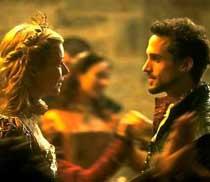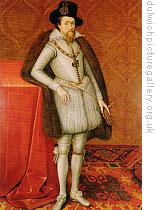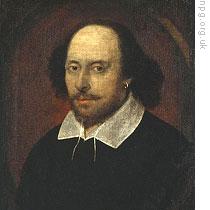VOICE ONE:
I’m Steve Ember.
VOICE TWO:
And I’m Barbara Klein with EXPLORATIONS in VOA Special English. Today, we complete our story about the influential English writer William Shakespeare. He wrote plays and poems during the late fifteenth and early sixteenth centuries. They remain very popular today.
VOICE TWO:
 |
| Gwyneth Paltrow and Joseph Fiennes in the 1998 film ”Shakespeare in Love” |
Last week, we talked about Shakespeare’s history, his plays, and his poems. Today, we talk about the events and cultural influences that affected Shakespeare and his art. We also discuss the countless ways his works have influenced language and popular culture.
VIOLA: “Master Shakespeare …
[Dancing]
Good sir, I heard you are a poet …
[Shakespeare smiles, silent]
But a poet of no words?”
VOICE ONE:
That was part of a dancing scene from the popular nineteen ninety-eight movie “Shakespeare in Love.” The film suggests one way in which Shakespeare might have been influenced to write “Romeo and Juliet:” because of his relationship with a brave and lovely woman. The movie is only very loosely based on real events, but it is a wonderful story.
VOICE TWO:
Many of Shakespeare’s works were influenced by earlier writings. During this time, students would probably have learned several ancient Roman and Greek plays. It was not unusual for writers to produce more current versions of these works. For example, in his play “The Comedy of Errors” Shakespeare borrows certain structural details from the ancient Roman playwright Plautus.
VOICE ONE:
 |
| James the First |
For his tragic play “Macbeth,” Shakespeare most likely used a work on Scottish history by Raphael Holinshed for information. It is also no accident that this play about a Scottish king was written a few years after James the First became King of England in sixteen-oh-three. This new ruler was from Scotland and London was alive with Scottish culture. Shakespeare may have borrowed from other writers, but the intensity of his imagination and language made the plays his own.
VOICE TWO:
Shakespeare was also influenced by the world around him. He describes the sights and sounds of London in his plays. His works include observations about current political struggles, the fear of diseases, and the popular language of the city’s tradesmen and other professionals.
Shakespeare’s knowledge of the English countryside is also clear. His works include descriptions of deep forests, local flowers, and the ancient popular traditions of rural people.
VOICE ONE:
Shakespeare became a well-known writer during a golden age of theater. His years of hard work paid off. Over the years, he invested income from his acting company by purchasing land and other property. He retired to the countryside a wealthy man. William Shakespeare died in his hometown of Stratford-upon-Avon in sixteen-sixteen at the age of fifty-two. While many plays by other writers of his time have been forgotten, Shakespeare and his art live on.
(MUSIC)
VOICE TWO:
It would be impossible to list all of the ways in which Shakespeare’s works have influenced world culture. But we can give a few important examples. The first example would have to include his great effect on the English language. During his time, the English language was changing. Many new words from other languages were being added.
VOICE ONE:
 |
| A famous, but disputed, portrait of William Shakespeare at the National Portrait Gallery in London |
Shakespeare used his sharp mind and poetic inventiveness to create hundreds of new words and rework old ones. For example, he created the verb “to torture” and the noun forms of “critic,” “mountaineer” and “eyeball.” Many common expressions in English come from his plays. These include “pomp and circumstance” from “Othello,” “full circle” from “King Lear” and “one fell swoop” from “Macbeth.”
The Folger Shakespeare Library in Washington, D.C., is the home of the largest collection of Shakespearean materials in the world. For example, it contains seventy-nine copies of the first printed collection of Shakespeare’s plays. The First Folio was published in sixteen twenty-three, after his death. It contained thirty-six of his plays. Without this important publication, eighteen of Shakespeare’s plays would have been lost.
The Folger also has more than two hundred examples of Shakespeare’s Quartos. These earlier publications of the plays were smaller and less costly to print.
You might be wondering which versions of Shakespeare’s plays are read today. Scholars who work on publishing many of the plays make careful choices about whether to use words from the First Folio, or the Quartos.
The Folger Library also holds exhibits about the Renaissance period and Shakespearean culture.
VOICE TWO:
The list of cultural creations influenced by Shakespeare is almost endless. From paintings to television to music and dance, Shakespeare is well represented. For example, the nineteenth century “Otello” by Giuseppe Verdi is an opera version of the tragic play “Othello.” It is about a ruler who believes wrongly that his wife has been with another man. One famous song from this opera includes the wife, Desdemona, mournfully singing “Ave Maria.”
(MUSIC)
VOICE ONE:
Over a century later, the American songwriter Cole Porter transformed the Shakespeare comedy “The Taming of the Shrew” into the musical play “Kiss Me Kate.” The musical was later made into a movie. Songs like “Brush Up Your Shakespeare” are popular favorites.
(MUSIC)
VOICE TWO:
In nineteen fifty-seven the famous jazz musician Duke Ellington released “Such Sweet Thunder.” In the song “The Telecasters” Duke Ellington musically recreates the three witches in Shakespeare’s “Macbeth.” Ellington uses three trombone instruments. His use of silent breaks adds a special tension to the song.
(MUSIC: “The Telecasters”)
VOICE ONE:
 |
| Natalie Wood in “West Side Story” |
Leonard Bernstein and Stephen Sondheim worked together on a modern version of “Romeo and Juliet.” Their popular musical play took place on the West Side of New York City. The opposing groups are a gang of young people and a group of new immigrants. The award-winning movie version came out in nineteen sixty-one. Here the main character Maria sings about the happiness of being in love in “I Feel Pretty.”
(MUSIC)
VOICE TWO:
It is not just new versions of the plays that live on in popular culture. Shakespeare’s plays have been translated into every major language in the world. All across the United States, the plays are performed in schools, theaters and festivals. There are over one hundred Shakespeare festivals and many permanent theaters that perform his works. In Washington, D.C., alone two theaters perform the plays of Shakespeare and other writers of his time.
We leave you with words of praise by Ben Jonson, a playwright who lived during Shakespeare’s time. Mister Jonson knew long ago that the works of Shakespeare would hold their magic through the ages.
(MUSIC)
VOICE THREE:
“Triumph, my Britain, thou hast one to show
To whom all scenes of Europe homage owe.
He was not of an age, but for all time!”
VOICE ONE:
This program was written and produced by Dana Demange. I’m Steve Ember.
VOICE TWO:
And I’m Barbara Klein. Our reader was Shep O’Neal. You can read and listen to this program on our Web site, WWW.VOA-STORY.COM. Join us again next week for EXPLOATIONS in VOA Special English.